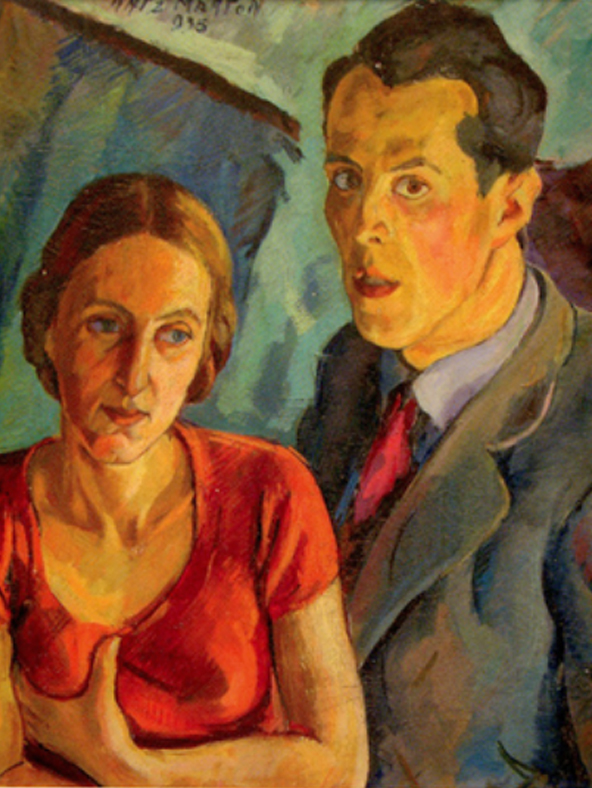Katz Márton

1912, Whitehall, USA - 1943, Sztara Jarussza, Ukraine
The Life
His father emigrated from Romania so he could make a better life for himself. The stride that got him in America made him envision a life without a struggle for the children that would soon follow. Katz Márton grew up with a plan for the future which was already set in stone, but his heart was longing for something else. He wanted to paint. Thus he abandoned the life that his father had planned for him and pursued an artistic career with a hint of a radical political affair.
The Art
Katz Márton was a visual artist, predominantly influenced creatively by the 1930s era. To understand his art, we have to understand the times in which he lived, meaning, in the midst of a political ideology clash. Marxist Socialism, Capitalist Democracy, and Totalitarianism were dominating Europe and influencing the art scenes on an international scale. Surrealism was appearing on the canvas of artists like Frida Kahlo and Diego Riviera in Mexico, and soon after, on the canvas of our artist who worked to incorporate the ideas posed by Surrealism into his radical political philosophy. He painted landscapes of Baia Mare, portraits of peasants and miners.
Chasing a dream
Towards the beginning of the 20th century, a steady flow of Jews fled their native lands because of persecution and lack of economic opportunity.
They embarked on an arduous journey to America, in search of the American dream everyone was longing for. Katz Márton's story starts here, with his father, Ignác Katz, who emigrated from Romania to America around 1910. The artist was born two years later, in Whitehall Michigan on February 16th, 1912. His father became the director of a tannery and was able to offer his son Márton a decent life, up to the point when they had to move back to Romania seven years later.
Dream until your dreams come true
Returned to Sighetu Marmației, his father landed in the middle of the Jewish community, where he was a respected member. The artist graduated from elementary school and high school in the city. Ever since he could form his ideas about his future, he manifested an interest in pursuing art. The family's view on the matter was different. They guided the boy towards an economic career by enrolling him in Economic and Trade Schools in Sighet, Dej, and Cluj Napoca. Márton's heart wasn't into economics but rather into painting.
While he was studying at the Dej Higher School of Commerce, he attended Sándor Szopos' drawing classes, where he met and befriended András Kunovits. He was the first to take Katz to Baia Mare, where they rented an apartment and attended the school of painters, in 1931. Márton tried studying drawing and economics in parallel, but after yet another year at the Academy of Commerce in Cluj, he gave up on school and decided to follow his genuine plan and become an artist.
Mixing art and political ideologies
Kunovits' rebellious spirit, modern artistic conception, and Marxist political views had a great influence on Katz. Together they were part of a group of young people (besides András Kunovits, Lídia Agricola, Lilla Csizér, Sára Káhán, and Olivér Pittner) whom Mikola excluded from the painting school in 1931, because of their ideologies and radical political views.
The following year, Márton Katz participated in the workshop led by József Klein, then continued his art studies under the guidance of Sándor Ziffer. Ziffer's mentorship had a great impact on his art. (Proof of his close relationship with the master being the Ziffer’s portrait of Katz painted in 1935).
In the summer of 1933, the group of young people set up a duplicate workshop in Ignác Katz's summer house (disguised as a holiday home) in Sighetu Marmatiei, to produce leaflets with an ideological theme. The illegal movement was exposed by the police on September 23, due to the reports of the locals. The young people were arrested. After a home search at the Csizér and Agricola family, the girls were released because the police couldn't find any incriminatory evidence. Katz on the other hand was convicted in front of the court in Maramureș and had to serve three months in prison.
According to Lídia Agricola, Ignác Katz paid fifty thousand lei to smooth out the problem with the authorities and help the young people escape. But from that moment on, Márton was constantly scrutinized by the police. In November 1934 he was arrested again, and his left-wing ideological newspapers ("Free world" and "Left") in which he published his drawings of social criticism, were confiscated from his apartment. Soon after getting out of jail, on December 22, 1934, he married the painter Lidia Agricola with whom he had a son named Ivan.
Fighting for what matters
The following year, the painting school he attended came under Manu's leadership, which made the artist publish a pamphlet in Bányavidék magazine to save the school in which he acknowledged the fact that "it is impossible to bring back the glory years of the colony". The same year, Márton participated in the congress of artists organized by Aurel Pop and then at the exhibition organized by the Union of Transilvanian and Banat painters. Two paintings signed by Katz Márton (portrait of a peasant and a landscape), were presented at the festive exhibition of the Association of Visual Artists establishment in Baia Mare in 1937, about which the critics highlighted "his orientation towards nature and social phenomena".
After the Second Vienna Award in 1941, those with leftist ideology were arrested again during police raids, including Katz. His last exhibition was a group one organized in Baia-Mare, on the occasion of the Festive Week “Szent István” in which he participated under the name of Márton Karcay. He showcased the paintings entitled “Strada Morii” (The street of the mill) and “Malul Săsarului”( The bank of Săsar). It was the same exhibition where Klein appeared under the pseudonym József Csermői.
The series of multiple arrests were followed by his deportation to a forced labor camp in Stara Yarussa Ukraine, where he died of typhus on January 19, 1943, two days before the village was liberated. No one in the Katz family survived the deportation: his father was shot in 1944 while having a nervous breakdown force-marched on the road, and his mother executed in a gas chamber.
Márton Katz was one of the most talented of the group of rebel artists, whose work, unfortunately, could not be completed. Starting from the traditions of Plein air painting, his main themes were the landscapes of Baia Mare, portraits of peasants and miners, made with remarkable social sensitivity.

